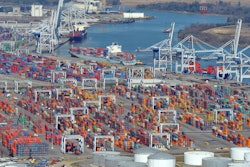
London, UK—Oct. 12, 2015—Slowing global trade and a bloated order book of large vessel capacity mean that container shipping is set for another three years of overcapacity and financial pain, according to the latest Container Forecaster report published by global shipping consultancy Drewry.
The recent slowdown in world trade forced Drewry to halve its forecast for container shipping growth for this year to just 2.2 percent and revise down estimates for future years. Meanwhile, an additional 1.6 million 20-foot equivalent units (TEU) of new capacity is being added to the fleet this year, equating to a growth rate of 7.7 percent. As a result, Drewry’s Global Supply/Demand Index, a measure of the relative balance of vessel capacity and cargo demand in the market in which 100 equals equilibrium, fell to a reading of 91 in 2015, its lowest level since the recession ravaged the year of 2009.
Consequently, spot freight rates across most key trades fell to historical lows, particularly on the Asia to Europe, Asia to East Coast of South America and Asia to Middle East trades. Carrier reliance on the monthly general rate increase (GRI) mechanism and void sailings to adjust capacity are not working.
“Were it not for the recent fall in bunker prices, shipping lines would be losing money,” said Neil Dekker, Drewry’s director of container shipping research. “They cannot continue to rely on this unexpected gift to maintain profitability.”
Some carriers are starting to take more radical action by removing significant capacity from certain trades. Two alliances each removed a single loop in the Asia to North Europe trade and the G6 alliance took out two strings this winter in the transpacific trade, although this is part of its usual winter redeployment. On the smaller trades, Maersk has removed its smallest service on the Europe-South Asia route. After a horrific year, five carriers decided to suspend their weekly service of Panamax ships operating between Asia and East Coast South America, which will remove around 6 percent of operational capacity.
However, with a further 1.3 million TEU due to join the global fleet in 2016, many routes that are currently experiencing problems will be further hindered by new deliveries and the continued global cascade. Drewry forecasts that its Global Supply/Demand Index will fall to its lowest level on record over the next few years, indicating that the overhang of excess capacity will be even greater than that experienced in 2009.
“The container shipping industry is in the midst of an overcapacity crisis, which will worsen next year,” warned Dekker. “How carriers and tramp owners address the overcapacity situation will influence the duration of the crisis. Shipping lines will need to idle a much larger portion of the fleet than they have hitherto been prepared to do. Otherwise, short of an unexpected recovery in traffic volumes, container shipping is set for several years of overcapacity and mounting financial losses.”












